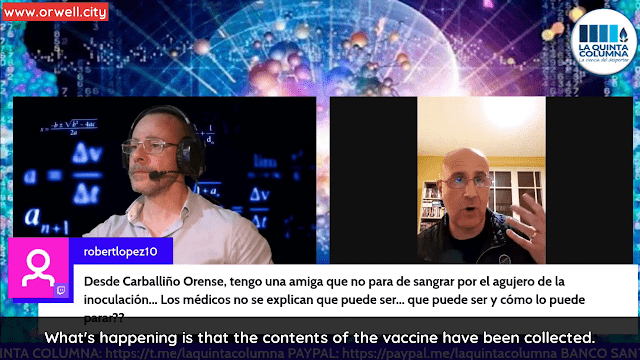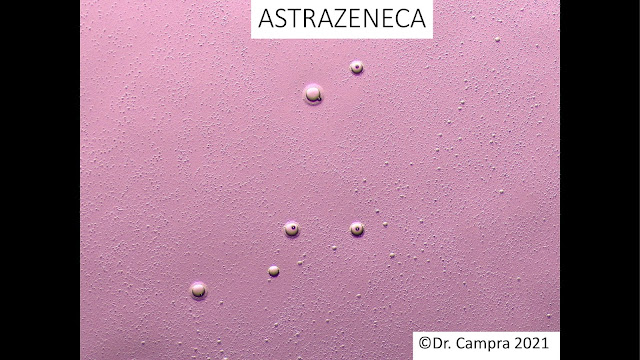
by ORWELLITO
Orwell City
Recently, Dr. Pablo Campra Madrid, the researcher who has been analyzing vaccination vials and working hard on a final and definitive expert report that will be published during this month, sent exclusive photographs of possible microbiota observed under electron microscopy to La Quinta Columna.
All of these photographs are part of the ‘Campra archive’ and, in part, are photographs that will be included in the final report.
It’s worth mentioning that, except for some identifiable materials, such as graphene oxide, the microbiota in the vaccination vials from Pfizer, AstraZeneca, Janssen, and Moderna laboratories are completely unknown at the moment.
Dr. Campra’s team and La Quinta Columna are doing various tests and will conduct further analyses to determine what’s observed.
Once again, Orwell City brings you the PDF presentation and program excerpt 159 in English.
Please, read carefully the notes made by Dr. Campra and what La Quinta Columna has to say about this new exclusive material shared with the world.
Ricardo Delgado: Our friend has just sent me, right now, an image made by him, and we’re going to show it with an attached commentary by Dr. Campra himself. Let’s take a look at it. Also, he has sent… We have a PowerPoint presentation that we’re going to share with you. It’s of all the microbiota that we’ve obtained, the one that’s inside the vaccine. Or it’s what we suspect that may be biology. Because you know this is… Let’s see. If I share a screen over here… Tell me, can you see it now? Yes you can, right?
Dr. Sevillano: Yes.
Ricardo Delgado: Well… The comment on this image is that these thin ‘hairs’ coming out of the tip —there are many kinds of objects like this in the vaccine—, especially, these hairs you can see on the tip of this fiber are likely to be graphene. Okay? And these hairs come out of there. It’s a very odd thing for this to be inside the vaccine. This madness is as big as a castle. I don’t know how to say it. Let’s take this image down, and I’m going to show a PowerPoint presentation now.
I think you can see it. Let’s take a look at it. Let’s see… Here it goes. We share the screen again. You can see it, can’t you?
Now we can. Great. Well, it says: ‘Observations of possible microbiota in COVID —supposedly— mRNA vaccines. Well, these images were sent in by Dr. Campra.
Pfizer.
All that stuff that you see there, really, it looks like… Well, it seems like it’s not moving, and it’s suspected to be microbiota. Likewise, this is right here. Here, it looks like it’s a little bit frayed, too. Over here, we also have something very strange. Pfizer. I don’t know what… It looks like graphene is visible around here. But, obviously, I don’t know if what we have here is a living organism or…
Dr. Sevillano: They look like intestinal parasites. I’ve never seen that in my life either.
Ricardo Delgado: Here we have another darkfield image.
Well, the truth is that it resembles the cosmos. The microcosm, in this case. I think this image is practically the same but in a bright field. But notice how this does look like a crystal or graphene.
And the hair is there, let’s say as if attached. Yes. It’s going to turn out that the Polish guy (Dr. Franc Zalewski) was right about these things feeding on graphene. Who knows! Here’s another one. Oh, I’m sorry. This one here was found in the Pfizer vaccine. Now in darkfield.
Anyway, this is all microbiota.
Some will claim it’s contamination. In fact, one troll has already replied today —a smartass— when we posted the video of the Janssen vaccines on Twitter. Someone has already replied: ‘Sure, and how do I know it’s not contamination?’ That is, they’re always looking for an explanation for…
This is very striking because it looks like an ‘ovo’. Like an egg. As if something were incubating.
Dr. Sevillano: A spore or an egg. Something like that. Life in germ. That is, it looks like something that, at some point, may hatch.
Ricardo Delgado: Yes, like it may hatch. But this is —in my opinion, in my humble opinion—, what I see here right now, from what we have characterized, is that it’s something alive, almost certainly. That it looks more organic, let’s say, because of the shape and so on. Here is the same. Here we have this… To the field, sure. Here, in the Pfizer vaccine, you see, again, something that shouldn’t be.
Well, there shouldn’t be any of this in it. These hairs that we see here in the middle… I don’t know if they’re the famous Morgellons. They look similar.
Let’s see another image. Remember, we’re looking at the content of the Pfizer vaccine. Here you don’t see nanoparticles or anything of what they tell us. This image is very striking because notice, again, those ‘hairs’ at one end.
Dr. Sevillano: This one is very good too.
Ricardo Delgado: Now let’s look at the AstraZeneca ones. There you see something like a cumulus. A globule. This is the typical egg we saw earlier, but, now, in a clear field. And we’re now looking at AstraZeneca. But, notice that the typology is practically the same in one and in the other. In AstraZeneca, you can also see some bands.
This is the famous mushroom that we also saw. Something very weird, isn’t it?
Dr. Sevillano: Yes.
Ricardo Delgado: That also appears to be organic. Here, also, it looks as if in AstraZeneca there is doped graphene. And one of those thin hairs over there. Here you see a series of little eggs. They have some kind of dot in the central nucleus. I don’t know if it’s the glow. Although I don’t think so. Because in these two it doesn’t appear, but it does in these two. And it’s as if they were germinating or incubating something.
Dr. Sevillano: They’re in a different stage of development.
Ricardo Delgado: Yes. And this one has it on the outside if you notice. Can you see it? What a weird thing. This image is very striking as well. Here it looks like a coiled hair on this other strip. Well, now we’re looking at what’s in the Moderna vaccine.
But you notice that the typology is similar. I have been told that this image is the famous tentacle of the octopus but seen closer. Yes. It looks like graphene. I don’t know. It looks doped, too. Probably, with some metal. I don’t know. More things are found in Moderna.
This one. This one that we saw yesterday and caught our attention in Janssen. It seems that in Jansen’s vaccine, there’s another type of typology. Different. I don’t know.
Dr. Sevillano: We know that we’re going to perform spectroscopy on one of those hairs, too. To those… Let’s say, skeletons that you see, like insect wings or whatever.
Ricardo Delgado: Yeah.Dr. Sevillano: We just don’t know what it is. They could be carbon, maybe. Let’s see if all that gives us the result of carbon. Let’s see.
Ricardo Delgado: We saw this one yesterday, too.
Dr. Sevillano: Yes, we saw it.
Ricardo Delgado: What a strange distribution. Here it’s in darkfield and closer up. But it’s the same as this, I understand.
Here you can see the central polymer. The nucleus, let’s say. And, then, the hairs appear in an arrangement of type…
Dr. Sevillano: Lobular. That’s what it’s called. As if they were lobes.
Ricardo Delgado: Right. It’s weird. We saw this too.
Dr. Sevillano: Yes.
Ricardo Delgado: Then, we’re going to see an article from our friend from Corona2. The one who has the blog and who comments about this type of structure. And this is what we commented on yesterday.
We don’t know to what extent crystals can be distributed in space in that way. I have no knowledge about this.
Well, that’s what we have for now. Tomorrow, surely, we’ll show more videos. But the truth is that, as you can see, in Janssen, Moderna, AstraZeneca, and Pfizer there’s this type of object typology. And this should not be, as far as we know, in any of the vaccines.
Dr. Sevillano: And it’s not contamination. Because the vials were sealed. The ones that came open have never been used for these things. Those have been used for other purposes. We have done other things with them, like leaving them in culture, to know if there are things that move or not. We’re even going to try to put this in culture, as suggested to us yesterday in the program. At a temperature of 36ºC. Let’s see what comes out of it.
Yes, yes, yes, yes. We take into account all the ideas that you share with us. But it’s not contamination. These images come from sealed vials that have kept the cold chain.







































